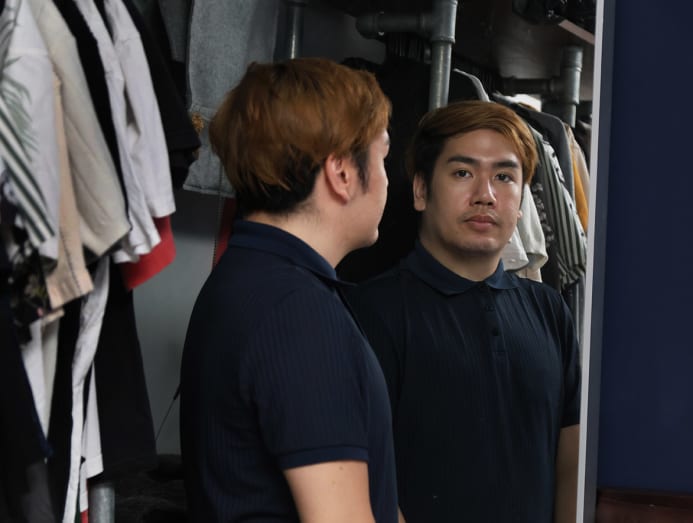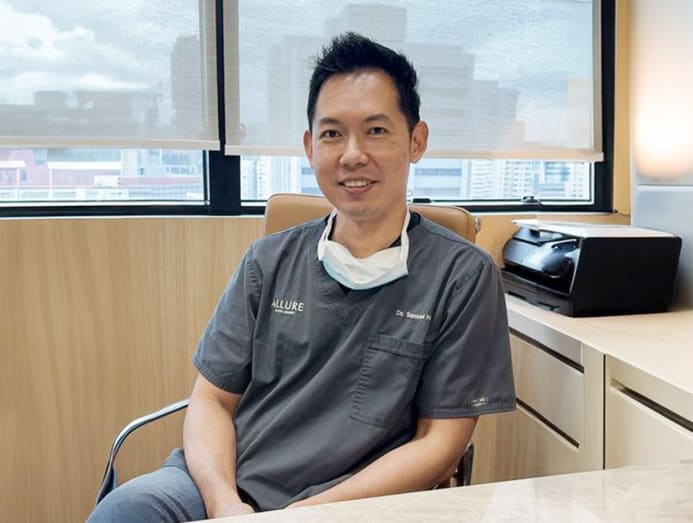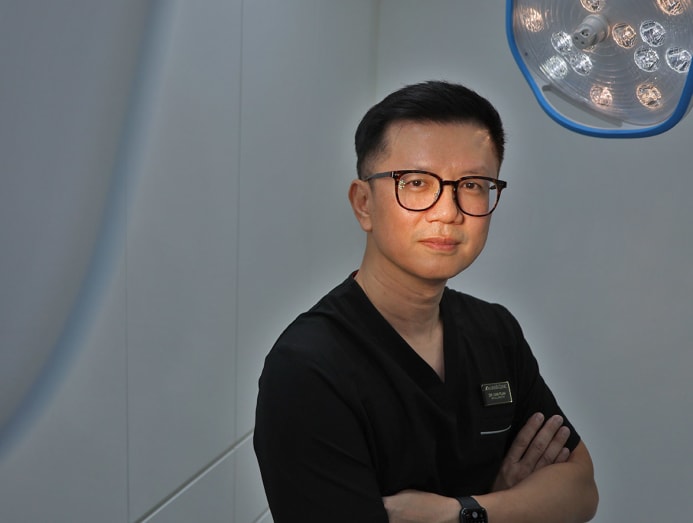Best chest forward: Why we need to talk about 'man boob' surgery
SINGAPORE — Despite years of trying to lose weight, Mr Benedict Leong struggled to shed the excess fat around his chest and could not understand why.
The 30-year-old who runs a pet service business has been dedicating himself to intermittent fasting and various exercises, seeing improvements elsewhere in his body, but the weight around his chest stubbornly remained and even seemed more prominent.
“My entire life, I’ve been told, ‘You’re a bit heavy' or 'You’ve gained weight'. So I thought anything that looks fat means that it’s just a weight-related problem.”
Feeling like he had hit a wall, he decided to visit the doctor, where he was diagnosed with gynaecomastia or enlargement of the male breast tissue.
Colloquially, this is sometimes called "man boobs" or just "moobs", though these are not terms that medical professionals tend to use.
The impact of the condition is mainly psychological, though it can also cause discomfort for some.
For Mr Leong, it was both a surprise and a relief to know that it was a medical condition and had nothing to do with weight. Moreover, it can be easily treated with day surgery with very little downtime.
“I realised that it’s not my fault. It wasn’t that I was not doing enough,” he added.
“I didn’t realise it is a condition that can be rectified.”
“I decided to go and do it (the surgery) and ever since then, I’ve been feeling great.”
He went for surgery in February.

Mr Leong is not alone when it comes to gynaecomastia. Doctors contacted by TODAY said that they have been seeing an increase in men, especially those in their 20s to 30s, visiting their clinics to seek treatment for the condition.
There are no official statistics for the number of men being treated here, but one doctor said that based on international studies, on average, 60 per cent of men worldwide exhibit gynaecomastia to some degree.
Dr Ivan Puah, medical director of Amaris B Clinic, added: “The prevalence of asymptomatic gynaecomastia is 50 per cent to 60 per cent in adolescents and up to 70 per cent in men who are 50 to 69 years old.”
Asymptomatic gynaecomastia refers to cases of gynaecomastia that occur in men with no identifiable cause.
Dr Samuel Ho from Allure Plastic Surgery said that although there seems to be an increase in men going for gynaecomastia treatment, this does not necessarily indicate a prevalence of the condition in Singapore but rather a greater incidence of it.
“(The number of cases) probably has increased over the years because of awareness,” he added. Dr Ho noted that he has seen more cases in the last five years.

Indeed, on the online forum Reddit, there are several threads from online users in Singapore discussing their experience and sharing information about gynaecomastia.
Users on the thread shared insights into which clinic they prefer, the cost of surgery and share post-operative experiences.
Dr Puah said that even with online discussion, there is a stigma that stops men from seeking treatment.
“Men may be hesitant to seek medical help or discuss their concerns due to fear of judgment or embarrassment.”
Dr Ho said: “Just because you’re aware doesn’t mean you would want to get treated because sometimes, they may not know that there are treatment options.”
As common and benign as gynaecomastia is, it is still a widely misunderstood condition. TODAY asked the doctors and patients to shed some much-needed light on the topic.
WHAT IS GYNAECOMASTIA?
Broadly, there are two causes of gynaecomastia: Physiological and pathological.
Dr Samuel Ho from Allure Plastic Surgery said that physiological gynaecomastia is usually caused by a shift in hormones that occurs during two stages in a man’s life.
“So it is periods of a lot of hormonal shifts. That's the age groups when they are post-pubertal (in their youth) and when they are post-andropausal in their 50s and 60s.”
Dr Ho also said that it is extremely common for boys going through puberty to develop gynaecomastia, where up to 70 to 80 per cent experience it. However, there is a chance that it can resolve by itself and surgery might not be needed.
Andropause, often referred to as male menopause, is a phase in a man's life typically associated with a gradual decline in testosterone levels, usually in middle-aged and older men.
As for pathological gynaecomastia, it is usually caused by medication, illness or the use of anabolic steroids.
Doctors told TODAY that some medications can have side effects that cause gynaecomastia, including antidepressants and calcium channel blockers.
Dr Ivan Puah from Amaris B Clinic said there is a myth that gynaecomastia affects only overweight or obese individuals, and it is not true.
“Gynaecomastia can occur in individuals of any body weight,” he added.
“While excess fat can contribute to the appearance of enlarged breasts, hormonal imbalances and other factors can also cause gynaecomastia in individuals who are not overweight.”
THE SURGERY AND COST
Doctors who spoke to TODAY said that the treatment for gynaecomastia is quite straightforward and can be done in an hour or two.
A patient undergoing this surgery typically goes through the usual processes of physical examinations, blood tests and ultrasound tests to determine and confirm the diagnosis.
Gynaecomastia is classified into four grades, with the first grade being the less noticeable to the fourth grade being the most pronounced and breast-like.
Most often, the surgery involves a small incision of 2cm around the areola (area around the nipple) to remove the breast disc and some fat.
The technique varies from plastic surgeon to plastic surgeon and is also dependent on the patient’s condition.
Dr Tan Chuan Chien, consultant general surgeon of breast and thyroid surgery at SOG Health, said that medical advancement, minimally invasive surgical techniques and improved medical therapies are some of the emerging trends in gynaecomastia treatment.
“These advancements offer better surgical outcomes and quicker recovery times for patients.”
Dr Ho said that some patients can go back to work the next day if they want to, and most patients can return to physical exercise after a week.
Mr Leong said of his experience: “I think the first few days, there was just a bit of discomfort because it’s a wound.
“We do have to wear the compression garment, which took a while to get used to, but I think after about a week, I was fine.”

The cost of surgery varies depending on the clinic, but it can cost anywhere from S$15,000 to S$20,000. However, because it is a medical condition, it is fully covered by the Central Provident Fund's MediSave or by an insurance provider.
For Mr Leong, his surgery cost S$15,000 and was completely covered by his insurance.
“That was something that was pleasantly surprising,” he said. “I didn't know that this can be covered under insurance as a legitimate medical condition.”
Dr Ho said: “The guys that go through it will discover that the whole process is quite simple.
"It is the ‘before’ of getting to the consulting room that really hampers them.”
DEALING WITH BODY IMAGE
Even though gynaecomastia is a physical condition, its psychological effects are more than skin-deep, and an hour’s surgery can make a world of difference.
For Mr Leong, who had always been insecure about how his chest looked, he was more than thrilled to wake up to a flatter chest.
“Immediately after the surgery, when I looked at myself, I said, 'Wow, that is a major change’ because I’ve always seen myself with protruding chest.”

There is a level of “social embarrassment” for men when their chest does not conform to a certain ideal.
Mr Leong added: “For men, there has always been a major focus on the upper body, on the chest and the abs. That’s generally the first thing when we try to draw the ‘perfect’ physique for a male.”
This was compounded by the subliminal messages that Mr Leong received during his schooling days, where the guys in sports co-curricular activities were “favoured” by people in general. He himself was in drama club as the “artsy fartsy kid”.
“Everybody was perpetuating a particular kind of ‘look’, especially with certain celebrities that look a certain way, and everybody would fawn over them... So I think subconsciously, all these bits and pieces start formulating an idea of what a man should look like.”
In the Reddit post about gynaecomastia surgery, a user named “Queasy-Wear-1” said that he was “depressed” because of his gynaecomastia.
He commented: “Every shirt you wear can see those puffy sharp nipples, which is very awkward so I end up slouching hard so it was not obvious. I can’t go swimming with friends, I can’t go shirtless. So there are a lot of (things) I can’t (do) there was no confidence at all.”
Singapore, like many other societies, has certain body image ideals for men, Dr Puah said.
“The emphasis on a lean and muscular physique often leads to increased concern or dissatisfaction among men with gynaecomastia.”
Still, the condition is extremely common and treatable, Dr Tan said.
The majority of those who undergo the surgery, like Mr Leong, are very happy with the results.
“When I look at myself in the mirror, I feel great,” Mr Leong said, “and I know that it won’t come back.”
“I can continue to work on other things that I want to work on in my life. It’s not just an emotional relief but also a mental release for myself.”








